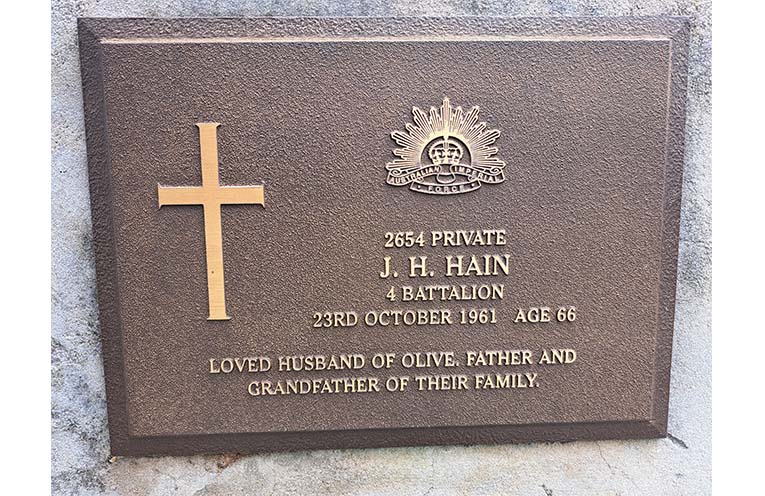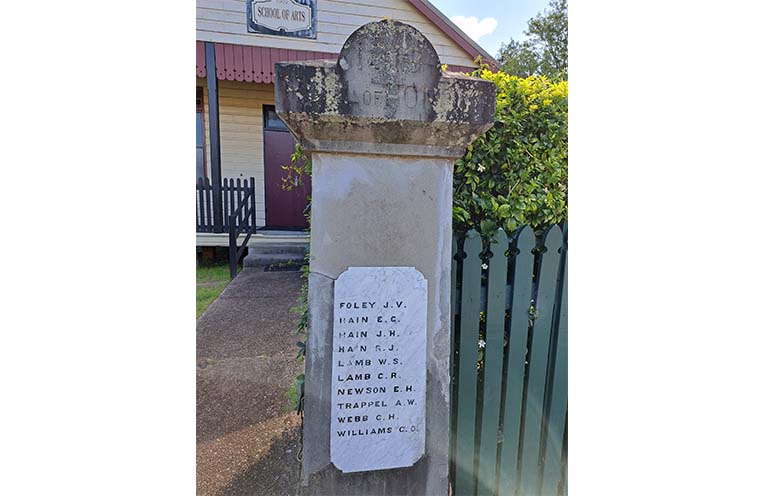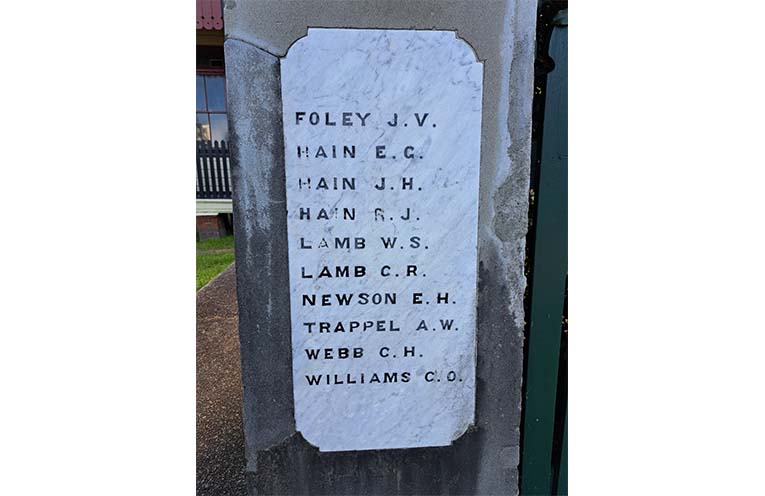
THIS story is part of a series about military veterans laid to rest at Dungog General Cemetery by Dungog RSL sub-Branch Vice-President Martin Holmes.
2654 PTE John Henry Hain – WW1 (AIF)
 Advertise with News of The Area today.
Advertise with News of The Area today.It’s worth it for your business.
Message us.
Phone us – (02) 4981 8882.
Email us – media@newsofthearea.com.au
John Henry Hain (known as Jack) was born at Seaham in 1895 to parents James and Margaret Hain.
John aged 20 years enlisted in the AIF on 2 August 1915 at Raymond Terrace.
He was the first of three brothers to enlist in the AIF.
Initially he was allocated to the 6th Reinforcements for the 19th Battalion as in August 1915, the 19th Battalion was already overseas on the Gallipoli Peninsular.
John spent the next few months in initial training before boarding the troopship HMAT A14 Euripides on 2 November 1915 in Sydney bound for Alexandria (Egypt).
He arrived at Alexandria in early December but did not join the 19th Battalion on Gallipoli as the Battalion was in the process of withdrawing from Gallipoli and had withdrawn to Lemnos (Crete) by 19 December.
On 7 January 1916 the 19th Battalion was back at Alexandria.
In January he was admitted sick to 1st General Hospital at Heliopolis (Egypt).
On 14 February, he, along with the rest of the 6th Reinforcements of the 19th Battalion, were instead allocated to the 4th Battalion (1st Brigade, 1st Division).
The 4th Battalion was at Tel el Kebir (110km NNE of Cairo Egypt) undergoing refit and training after evacuating from Gallipoli.
The unit undertook training until moving to Alexandria on 23 March where they boarded the troopship HMTS Simla for Marseilles (France).
Disembarking at Marseilles on 30 March they entrained for Steaenbecke (France).
On detraining they then marched for several days until reaching Petillon (France).
Here on 19 April they took over the trenches in the Armentieres sector and began a system of regular relief of the trenches.
The Armentieres sector was a relatively quiet sector on the Western front and used as an introduction for trench warfare.
On 10 July the unit began moving to Pozieres (France), part of the Somme battlefield, arriving on 19 July where they took over trenches from the 13th Royal Fusiliers.
The opening battle for Pozieres had begun by the British on 14 July with the Australians taking over and attacking on 23 July.
The 4th Battalion was in the first attacks beginning after midnight and involved in heavy fighting until withdrawn from the battle on 27 July after Pozieres was taken.
The Battalion had suffered intense artillery fire throughout the 25 July and the men suffered severely.
Over these five days the 4th Battalion suffered 421 killed, wounded or missing out of a unit strength of 946 at the start of the battle.
It was sometime during this period that John was wounded being shot in the right thigh.
John was evacuated from the battlefield being admitted to the 5th General Hospital at Rouen (France) on 27 July. By 30 July he had been evacuated to the Graylingwell War Hospital in Chichester (England) where he underwent further treatment.
John recovered sufficiently by 18 August to be given a fortnight leave then reported to 1st Training Battalion at Perham (England).
On 10 September he proceeded overseas back to France and rejoined the 4th Battalion on 24 September.
At this time the Battalion was in the Ypres salient where it was a comparatively quiet period.
The Battalion moved back to the Somme and spent October and November taking part in attacks.
The weather was atrocious with deep mud and continual rain and water filling the trenches and battlefield.
The Battalion moved to Ribemont (France) on 2 December with members suffering from the effects of freezing wet conditions and battle fatigue.
On 5 December, John was evacuated sick from the field.
He was admitted to the 5th General Hospital at Rouen (France) on the 9 December and evacuated back to England being admitted to the 2nd Birmingham War Hospital, Birmingham on 15 December.
John was subsequently transferred to the 3rd Australian Auxiliary Hospital at Dartford for recovery.
He was diagnosed with deafness and determined no longer fit for military service.
On 24 February 1917, John was transferred to the 2nd Command Depot at Weymouth where he awaited repatriation to Australia.
On 4 May, John embarked on the troopship HMAT Themistocles for Sydney.
He disembarked in Sydney on 5 July and was given a welcome home party on 10 July by the residents of Seaham.
On 31 August, John was discharged from the AIF as no longer medically fit to continue serving due to deafness. Interestingly, John applied for a war invalid pension but the application was rejected on 23 August, no incapacity as a result of warlike operations.
Whether he was later successful in obtaining an invalid pension is not shown in his service record.
He returned to civilian life working as a railway porter in Dungog.
In 1919 he married Miss Olive May Wilson of Dungog and they remained in Dungog having six children.
John retired from the railways, remaining in Dungog until his death on 23 October 1961.
He was buried in the Dungog General Cemetery (Presbyterian Section).
As a returned soldier from WW1 his headstone was erected by the Office of Australian War Graves and has a bronze plaque.
John was issued the following medals: 1914/15 Star; British War Medal 1914-20; Victory Medal.
John’s service is recorded on the Seaham Hall Memorial Board and Memorial Gates 1914-18 at the entrance to the Seaham School of Arts, also the Dungog and District WW1 Honour Roll.
By Martin HOLMES CSM

